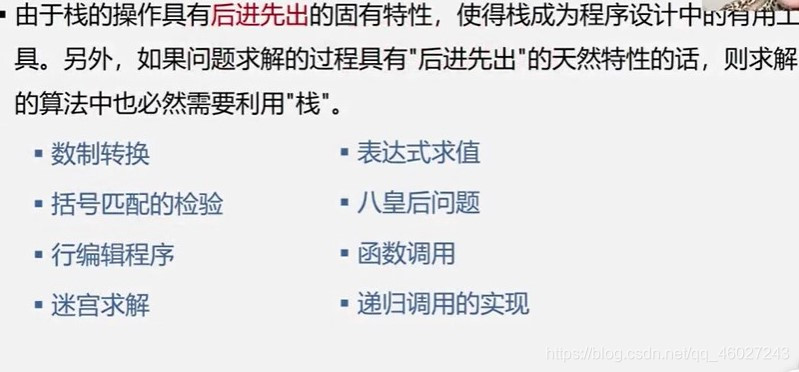一,栈的相关概念
1,栈的定义和特点


2,入栈和出栈


3,栈的应用

二,顺序栈的实现
#include<iostream>
using namespace std;
#define MaxSize 100
template<typename T>
class Stack
{
public:
Stack();
bool IsEmpty();
int GetLength();
int Clear();
void Push(T x);
void Pop();
~Stack();
private:
int top;
T *list;
};
template<typename T>
Stack<T>::Stack() //栈的初始化
{
top = 0;
list = new T[MaxSize];
}
template<typename T>
bool Stack<T>::IsEmpty() //判断栈是否为空
{
return top==0?1:0;
}
template<typename T>
int Stack<T>::GetLength() //获得栈中数据元素的个数
{
return top;
}
template<typename T>
int Stack<T>::Clear() //清空栈
{
top = 0;
}
template<typename T>
void Stack<T>::Push(T x) //入栈
{
if(top==MaxSize)
{
cout << "栈已满";
return;
}
else
{
list[top] = x;
top++;
}
}
template<typename T>
void Stack<T>::Pop() //出栈
{
if(top==0)
{
cout << "栈为空";
}
else
{
top--;
}
}
template<typename T>
Stack<T>::~Stack() //销毁栈
{
if(list)
{
delete[] list;
list = NULL;
}
}
int main()
{
}
三,链栈的实现
#include<iostream>
using namespace std;
template<typename T>
struct node //栈中存储的元素
{
T data; //元素的数据域
node* next; //指向下一个元素的指针
};
template<typename T>
class Stack
{
public:
Stack();
bool IsEmpty();
T GetTop();
void Push(const T a);
void Pop();
int GetLength();
~Stack();
private:
node<T>* top;
int count;
};
template<typename T>
Stack<T>::Stack() //链栈初始化
{
top = NULL;
count = 0;
}
template<typename T>
Stack<T>::~Stack() //链栈销毁
{
while(!IsEmpty())
{
Pop();
}
}
template<typename T>
bool Stack<T>::IsEmpty() //判断链栈是否为空
{
return count == 0;
}
template<typename T>
T Stack<T>::GetTop() //获得栈顶元素
{
if(!IsEmpty())
{
return top->data;
}
else
return 0;
}
template<typename T>
void Stack<T>::Push(const T a) //入栈
{
node<T>* s = new node<T>();
s->data = a;
s->next = top;
top = s;
count++;
}
template<typename T>
void Stack<T>::Pop() //出栈
{
if(IsEmpty())
{
cout << "栈为空";
}
else
{
node<T>* u = top;
top = top->next;
delete u;
count--;
}
}
template<typename T>
int Stack<T>::GetLength() //获得栈中元素个数
{
return count;
}
int main()
{
Stack<int> lists;
for(int i=1; i<6; i++)
{
lists.Push(i);
}
for(int i=0; i<3; i++)
{
lists.Pop();
}
lists.Push(6);
lists.Push(7);
lists.Pop();
int size = lists.GetLength();
for(int i=0; i<size; i++)
{
cout << lists.GetTop() << " ";
lists.Pop();
}
}